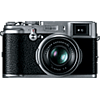Main
Model
Price
Advantages
launch
Announced
Body type
Camera subcategory
Sensor
Effective pixels
Max resolution
Sensor size
Sensor type
Processor
Image ratio w:h
Other resolutions
Sensor photo detectors
Image
Boosted ISO (minimum)
Boosted ISO (maximum)
White balance presets
Custom white balance
Image stabilization
Uncompressed format
JPEG quality levels
ISO
Photography features
Minimum shutter speed
Maximum shutter speed
Aperture priority
Shutter priority
Manual exposure mode
Subject / scene modes
Built-in flash
Flash range
External flash
Flash modes
Continuous drive
Self-timer
Metering modes
Exposure compensation
AE Bracketing
WB Bracketing
Screen / viewfinder
Articulated LCD
Screen size
Screen dots
Touch screen
Screen type
Live view
Viewfinder type
Viewfinder coverage
Viewfinder magnification
Viewfinder resolution
Videography features
Resolutions
File Format
Microphone
Speaker
Optics & Focus
Focal length (equiv.)
Optical zoom
Maximum aperture
Autofocus
Digital zoom
Manual focus
Normal focus range
Macro focus range
Number of focus points
Lens mount
Focal length multiplier
Physical
Weight (inc. batteries)
Dimensions
Environmentally sealed
Battery
Battery details
Battery Life (CIPA)
Storage
Storage types
Storage included
Connectivity
USB
HDMI
Remote control
Wireless
Wireless notes
Other features
Orientation sensor
Timelapse recording
GPS
GPS notes
Samples
Videos
Summary
The X-T1 highest resolution of 4896 x 3264 pixels (16 megapixels) is better in comparison with the FinePix X100 highest resolution of 4288 x 2848 pixels (12 megapixels). The FinePix X100 is produced with larger sensor than the X-T1: APS-C (23.6 x 15.8 mm) versus APS-C (23.6 x 15.6 mm). It is the most important difference between these models because large sensor lets the camera owner to produce photos of the higher quality. The X-T1 has more presets of white balance - 8. This option gives the camera owner more control over colour.
The X-T1 is equipped with tilting LCD that will let the camera owner to take images from any odd perspective. The X-T1 display is better as it has more screen dots 1,040,000 in comparison to 460,000 dots of the FinePix X100 display. The higher dot count display is better for reviewing photos on your camera.
The FinePix X100 is produced with built-in flash. The X-T1 is weather sealed which means that it provides protection from rain, snow, dust and sand. The X-T1 battery life is better than the FinePix X100 battery life. In accordance with CIPA standards the camera owner will be able to take 350 shots with the X-T1 and only 300 with the FinePix X100. The X-T1 weighs 440g that is 5g lighter in comparison with the weight of the FinePix X100. The X-T1 can utilize optional accessory GPS devices. Recording GPS data can be useful if you like to travel, to be able to check the photo metadata and find out exactly where an image was produced.
The X-T1 has 17 advantages and the FinePix X100 only 3 so the X-T1 becomes the best buy. Get the list of the best offers on Amazon.


